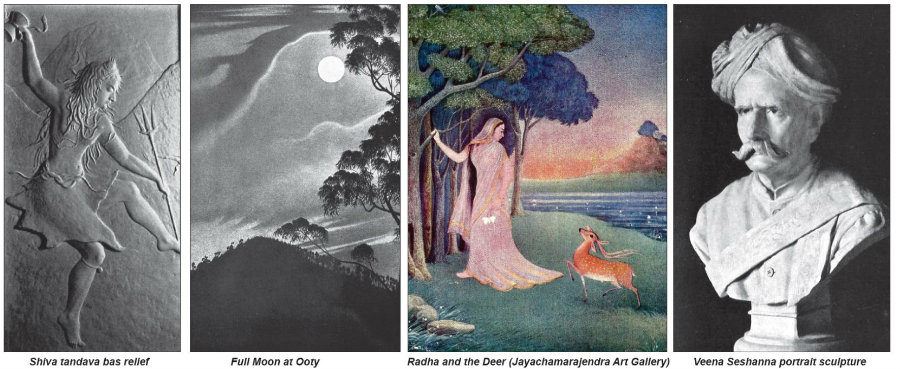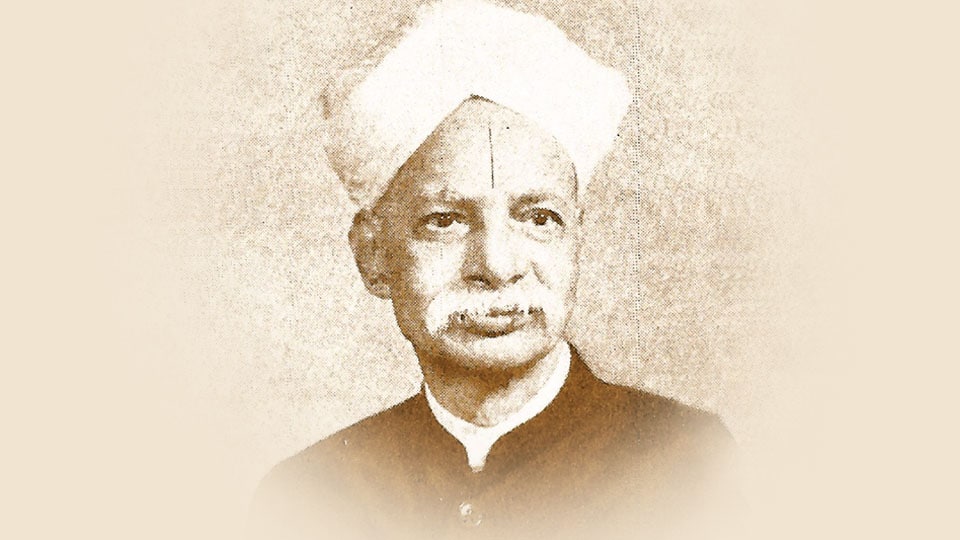By Dr. S.N. Bhagirath, Anaesthesiologist, Bangalore
Krishnappa Venkatappa, the renowned artist, painter, sculptor and musician was among the few artists of his time to embody the idealism of the revival movement. His family had come to Mysore from Chitradurga during the reign of Krishnaraja Wadiyar III and were accomplished court painters (chitragaras) who were known for their Gold-leaf work from the days of Vijayanagara Empire. He was born on 23rd June, 1886 at Mysore to Venkatappa and Rangamma.
The young Venkatappa would accompany his father to the Palace and thus imbibed a great yearning to pursue in his footsteps. His early education took place at the Government Industrial School in Nazarbad area from 1902-1908. Few years in this period were spent at The Arts School, Madras, which had till 1896, Ernest Havell as its President. From 1909 till 1916, he studied Fine Arts at the Government School of Arts & Crafts, Calcutta, where he came under the tutelage of Principal Percy Brown and Vice-Principal Abanindranath Tagore. About this time, along with Gaganendranath Tagore, he would do a few landscapes of the Himalayas from Darjeeling.
In 1910, he was chosen as a member of Lady Herringham’s team of artists for copying the frescoes at Ajanta. During this period, he worked on themes of Ramayana and Mahabharata. His studies of human figures included those of “Pratap Simha,” “Shankaracharya,” “The Buddha with Disciples,” “Damayanti,” “Tipoo Sultan” and “The Persian Lady.” The best remembered of these were those of “Ardhanareshwara” and the “Bengal Floriken” (1910) which won Venkatappa accolades from W. Rothenstein who described it as the perfect realisation of a bird’s figure. His mentor Abanindranath’s short note on “Chitra Shadanga” published in “Prabasi” wherein principles of measurement of art namely “Uttama Navatala Pramana,” “Sama Bhangi” and “Tribhangi” were enunciated had been translated from Bengali to English as “Notes on Indian Artistic Anatomy.” This included beautiful illustrations from Venkatappa and Nandalal Bose.
Interestingly, in 1912, while at Calcutta, he came under the influence of Srirangam Rangaswamy Iyengar — a disciple of Veena Seshanna. Having had his first brush with Veena, Venkatappa would be back in Mysore by 1916 and pursued learning Veena under Veena Seshanna for the better part of the next decade till 1927. Incidentally, it was in Veena Seshanna’s company that he would meet M. K. Gandhi for the first time in December of 1924 while at Belgaum. His devotion to music would be reflected in his famous work “Mad after Veena” probably his only autobiographical work.

Early in the last century, there was a controversy on number of Srutis in Indian Music. While musicologists from the West and East debated endlessly, Venkatappa produced a “Shruti – Veena” to establish conclusively that the number was 22. It is worth noting here that by the time K. Venkatappa came on the scene, Ravi Varma was in his mid forties and had established himself well. However, the criticism of Raja Ravi Varma was that his work was steeped in strict European traditional technique and therefore lacked the stylised characterisation of traditional Indian painting and sculpture — a niche that Venkatappa would come to fill rather appropriately.
From 1917 till 1934, he would produce many of his famous landscapes. Popular among these were those of Ootacamund and Kodaikanal landscapes. His technical note on “Tempera Painting” won him a prize in 1913. He was particularly known for preparing his own pigments and brushes. His Ivory miniature paintings “Abanindranath” (of his mentor), two portraits of Krishnaraja Wadiyar IV (Rajarishi) done in 1918 and two portraits of Maharaja of Cooch Behar (1926) were masterpieces in their own right. His plaster of paris sculptures were lifelike. His plaster sculpture “Mani” of a young boy who served him in a hotel in Mysore was telling in its realism. Other notable plaster sculptures include “Veena Seshanna” and “Portrait of Tagore.”
His circle of friends while at Mysore included Bidaram Krishnappa, K. Vasudevachar, Muttayya Bhagavatar, ‘Tiger’ Varadachari, Lt. Col. A.V. Subramanya Raja Urs (Hon. ADC to Maharaja) and C. Ananda Rao (Mysore Nataka Sangha). He used to reside at Gopalaraju Urs Choultry in Old Agrahara and later in Udupi Hotel at Santhepet. A diabetic, he was treated regularly by Dr. Parthanarayana Pandit.
By 1930, Venkatappa had been invited to do Bas Reliefs at the Amba Vilas Hall in Mysore Palace. Here he used the “Chiaroscuro Effect.” His reliefs were mainly “The Great Renunciation,” “Buddha the Mendicant,” “Rama handing the Signet ring to Hanuman,” “Drona teaching archery to Pandavas,” “Ekalavya practising archery,” “Dance of Shiva” and “Parting of Shakuntala.” Sadly this work, while stupendous in its execution, did not conclude in the most pleasant terms. Apparently, Venkatappa was promised a grand sum of Rs.40,000 from the Palace administration for the said work. This amount, needless to say, did not reach him and Venkatappa is believed to have taken legal recourse to secure his rightful payment.
This bitter experience must have prompted Venkatappa to leave Mysore and he subsequently relocated to Bangalore by the 1940s. His circle of friends in Bangalore included H.J. Bhabha (FRS), Vikram Sarabhai and his wife Mrinalini, Kamaladevi Chattopadhyaya and the eminent art critic G. Venkatachalam.
Many awards and accolades came his way. He was made a Fellow of Lalit Kala Akademi in 1961. A Tamrapatra and Angavastra were presented to him at a special function at his residence by Lalit Kala Akademi, Delhi, in 1962.
His collections are spread out across many places such as “Sri Kasturibhai Lalbhai Collection” of Ahmedabad, “Jayachamarajendra Art Gallery,” Mysore, K. Rama Raju of Bangalore, “Venkatappa Art Gallery,” Bangalore and Collections of “Late Treasurywalla,” “Raja of Digpatia” and “The Tagore Family.” His wonderful artistic temperament, his creative brilliance and his ability to resurrect the uniquely Indian Traditional Technique in his work make them ever-lasting in their own right. This artist, sculptor and musician of yore passed away on May 25, 1965 at his residence in Bangalore. His legacy lives on in his timeless works.
e-mail: [email protected]








It is very interesting to read about Krishnappa Venkatappa, generally known as Venkatappa who is an renowed artist.